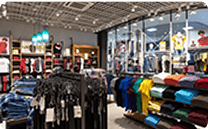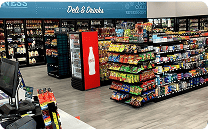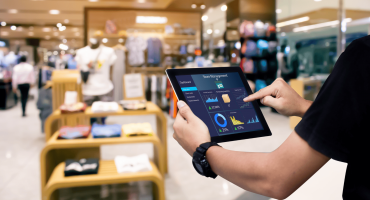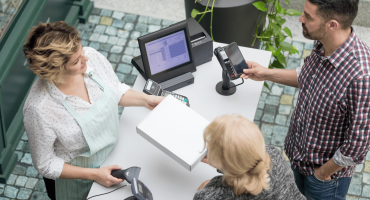In This article
Introduction
Retailers want more customers entering through the front door and exiting with paid merchandise. They are also eager for more trucks to arrive with inventory at the back door. This flow of commerce represents trillions of dollars in transactions, making retailers vulnerable to shoplifting, fraud, employee theft, and other security threats. Smart retailers implement retail loss prevention best practices, strategies, and programs to protect their business assets and bottom line.
With the guidance of a loss prevention security company, retailers are fighting back with an array of retail loss prevention strategies:
- More advanced surveillance cameras and systems.
- Continuous employee training.
- Updating security at entry points.
- Inventory control technologies.
- Regular reassessment of loss prevention methods.
Understanding Retail Loss Prevention
Retail loss prevention employs various security measures to counter the numerous forms of retail theft affecting retailers worldwide, ultimately aiming to minimize shrinkage. Inventory shrinkage accounts for substantially more than $100 billion annually in the United States, and 13% of small business owners reported in 2023 that retail theft occurred daily in their stores.
Retail loss prevention strategies also minimize a store’s financial losses by reducing the loss of merchandise. A proactive approach has many benefits:
- Strategic placement of AI-powered security cameras for better coverage and clarity.
- Inventory tracking and alarm technologies warn of suspicious movement of merchandise.
- Enhancing employee awareness of theft tactics enables a quicker response to incidents.
- With loss prevention methods in place, retail stores operate more efficiently and serve a greater number of customers.
Common Types of Retail Losses
The common types of retail losses are as old as ancient marketplaces. Whenever and wherever, street vendors and the largest retail chains are always susceptible to theft, inventory damage, and other losses. A comprehensive and dynamic loss prevention program can successfully address the oldest and newest types of retail losses.
- Shoplifting is likely the oldest type of retail loss and is typically committed by individuals.
- Retail loss from employee theft: Merchandise theft, manipulation of customer transactions, and other fraudulent activities.
- Vendor interactions, from inaccurate deliveries to invoicing errors to exploitation of supply chain weaknesses.
- Inventory damage from emergencies: fire, flood, and other weather events.
- Operational errors: Poor inventory control and audits, sloppy transactional management, and various pricing mistakes
Top Loss Prevention Strategies
The right combination of top loss-prevention strategies will create a safer business environment and can identify and plug loss-prevention gaps. The application of a single loss prevention strategy can’t stem the tide of retail loss, but there are many loss prevention methods to block the tactics that lead to losses.
- Advanced surveillance systems incorporating artificial intelligence (AI) and machine learning (ML) enable enhanced object and facial recognition, as well as improved motion detection.
- Employees are the human element in loss prevention strategies. With proper training, they complement surveillance systems by providing additional sets of eyes on the shopping floor to recognize suspicious activities.
- Access-control systems, including keycards, biometric authentication, and other methods, limit access to inventory.
- A loss prevention program should include regular reviews of cash and other transactions, as well as an analysis of sales data for signs of internal fraud.
Loss Prevention Best Practices
The successful application of loss prevention best practices depends on a proactive security mindset among ownership, management, and employees. Ownership must commit to retail loss prevention by investing sufficiently in security measures. Management must lead with loss prevention, keeping it at the forefront of their minds. By utilizing these best practices, employees’ workplaces are safer.
Critical loss prevention best practices include:
- Inventory is fluid; it is constantly in motion. Regular audits and reconciliations are vital for the most accurate status of merchandise.
- Develop a comprehensive security policy that outlines clear rules and procedures, and train employees accordingly. An employee accountability program explains responsibilities and the consequences of security lapses.
- Strategically placed signage will inform customers of the store’s proactive security policy. Customers will feel safer while shopping, and would-be shoplifters will be warned.
- Store layouts should be reviewed periodically, taking into account the positioning of surveillance cameras and employees. Eliminating blind spots and low-light areas enhances the value of loss prevention best practices.
Implementing Effective Loss Prevention Programs
Implementing loss prevention programs that effectively reduce losses and deliver an excellent return on investment (ROI) requires time, effort, and the commitment of everyone at the store to enhanced security. Some disruptions may occur with the launch of a loss prevention program. Nonetheless, implementing an effective loss prevention program has been proven effective at many stores.
- Begin by creating a loss prevention team of ownership, management, and employees. By establishing loss prevention strategies and best practices, employees are more likely to buy into the program, and roles and responsibilities will be thoroughly understood.
- Take advantage of the latest technologies, especially AI and machine learning. AI can also automate certain aspects of data analysis and provide predictive insights.
- Theft prevention technology, such as surveillance cameras, real-time inventory tracking, and smart shelves, delivers the most value when connected to point-of-sale (POS) and other financial systems.
- Outsourcing loss prevention to an expert third party allows you to spend the time you would have to spend investigating an incident on other areas of your business while keeping more money in your bottom line.
Effective Loss Prevention Methods
Retailers have a comprehensive array of effective loss prevention methods available, which equips them to detect and deter theft and fraud. Implementing and using these methods is a team effort. Ownership must demonstrate its commitment to minimizing loss prevention by investing in effective loss prevention methods. Employees must be just as serious about their security training and developing an awareness mindset about loss prevention.
Critical loss prevention methods:
- Because theft, fraud, and inventory damage are the primary causes of loss, protecting against them with RFID technology and barcode tracking can lead to effective loss prevention. Inventory is tracked in real-time, and even remotely.
- Electronic article surveillance (EAS) technology can detect a possible theft by attaching an electronic tag to each item and activating alarms to alert employees.
- Smart shelves are another effective loss prevention method. Employees receive an alert when merchandise is removed, allowing them to monitor customer behavior.
- Customers are also important members of the loss prevention team. Involving them in detecting shoplifters and their feedback about store security will prove valuable.
Measuring Success & Continuous Improvement
Even with the best intentions to implement a robust retail loss prevention program, invest in advanced security technologies, and thoroughly train the staff, success must be measurable. What is learned from that analysis reveals which aspects of a loss prevention program need improvement. This should be a continuous process of regularly scheduled analysis and adjustments.
- Data is the basis of analyzing the success of retail loss prevention strategies, including shrinkage rate, loss trends, recovery rates, and incidents of loss, among others.
- Regular reassessments and inspections of a store’s entire security system can maximize ROI and reveal security gaps.
- Much can be learned about the effectiveness of loss prevention best practices by analyzing video data from security cameras, including blind spots and low-light conditions.
- Observing employee activities and their level of commitment to prevent loss is another key metric that may indicate whether new or remedial training is required.
- Customer and employee surveys can also be helpful, providing feedback from their perspectives about the value and success of loss prevention programs.
Conclusion
Shoplifters, other retail criminals, and employees and suppliers committing fraud continue to pose threats to retailers everywhere. Those who cause retail loss are not stopping, so retailers must plan and implement loss prevention best practices, strategies, and programs to minimize loss and deter those targeting their stores.
Retailers need a proactive, not reactive, mindset to be at least one step ahead of the criminals. By investing in advanced technologies that provide a safer and more secure shopping experience, as well as improved inventory control, retailers are more likely to realize the greatest value and benefits. Retailers can minimize losses by continuously reassessing and adapting new loss prevention strategies, measuring their efficacy, and thereby boosting profitability and protecting the bottom line. To learn more about DTiQ loss prevention solutions and services, visit our website.






























